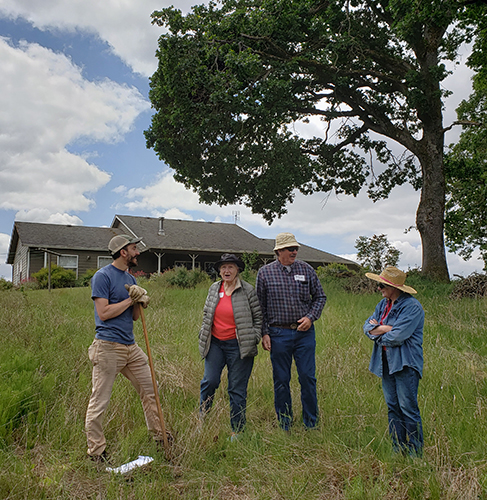By James Day
Kurt Berning is a born experimenter. In another era you would have seen him in greasy jeans with his head under the hood of an old Packard. Or at another time, perhaps, in his garage with a fellow tech geek developing a home computer with a four-inch screen.
Instead, we find him in 2023 in his laboratory: a patch of earth northeast of Mount Angel. His “farm vehicle” is a Prius. The challenge: What is the best way to restore oak habitat in the mid-Willamette Valley?
Berning, who first spoke with Our Town’s Melissa Wagoner about his oak project in early 2021, offered a tour and update on his multipronged oak undertaking in May to about 25 people.
The event, sponsored by the Conservation Club, the Marion Soil & Water Conservation District, the Institute for Applied Ecology, the Confederated Tribes of the Grand Ronde and the city of Salem, also stopped at oak projects in Salem and Champoeg State Park.
Berning’s oak lab consumes about four to five acres of the 16 acres his family has been farming for four generations. He points out the 10 full-grown oak trees that remain on the property while his guests walk along a mown path to a low-lying area near Zollner Creek.
Berning, who says he “dreams about oak trees,” notes the challenge of oak restoration: “For every 100 oaks that used to be in the Willamette Valley there are three now.”
The weeds grow to the height of a human adult in the area every year, and after mowing down the grasses Berning found that some oaks also came back during the regrowth period. He pointed out one three-year-old sapling, which has grown to six feet high. Berning plans to take out a couple of Douglas firs on the parcel (Doug firs are an invasive species in an oak savanna) but otherwise he is letting nature take its course with the oak saplings.
“Some areas you leave alone and some you have to work on,” he said.
Then, the tour moves to the side of the house to a small plot that coincidentally faces the farm’s 10 oaks. Nine are clumped in one tight grove, while the tenth stands like a sentinel west of the house.
Berning has planted a handful of oak seedlings in the plot, now about six inches high. One tour member, perhaps optimistically, shared concerns about the danger of a full-sized oak tree that close to the house, but Berning seemed inclined to let the experiment continue.
Oaks produce acorns, which serve as seeds for future trees. Berning has also been experimenting with growing oaks from acorns in narrow deep pots near the driveway.
“They haven’t done well,” Berning said. “I’d almost advise people not to do it. This is their second year growing and they look a bit stunted. It’s a whole different world working with pots.”
The final tour spot is the big one, four acres at the edge of the property where he used a grant to purchase 650 oak saplings now planted in a series of rows.
He also planted about 50 Willamette Valley (ponderosa) pines and 300 acorns.
“I’m trying to seed in natives and have them compete,” Berning said. “I’m hoping to control things I want to control.”
As with the other oak experiments this plot poses its challenges. Voles are a problem, although they are less trouble at the north end of the plot, with Berning surmising that predators use the refuge of a conifer grove to launch sorties on the voles.
The oak farm also is within 50 yards or so of the greenhouses of a commercial nursery, whose owners are not enthusiastic about Berning’s lab specimens blowing in their direction. So Berning is working to screen the nursery.
He says the pines are doing well.
“They are a good compliment to the oaks,” he said.
No thinning is planned for the near future, although Berning is hopeful that some energetic volunteers will come forward to help with the weeding (contact Berning at [email protected]).
At the end of the tour Berning returns to the challenge of the valley’s loss of its oaks, noting that despite his family property boasting 10, the two adjacent properties combine for just one.
“I’m just trying to give back,” he said. “There are so many benefits to this work and the value seems so clear. A person with just a little time on the weekend… you can do a lot. And there’s a lot to know about how to do it right.
“All my father’s farmer buddies come by and say ‘what is he doing?’ But I say come back in five years. I know it’s messy right now.”
